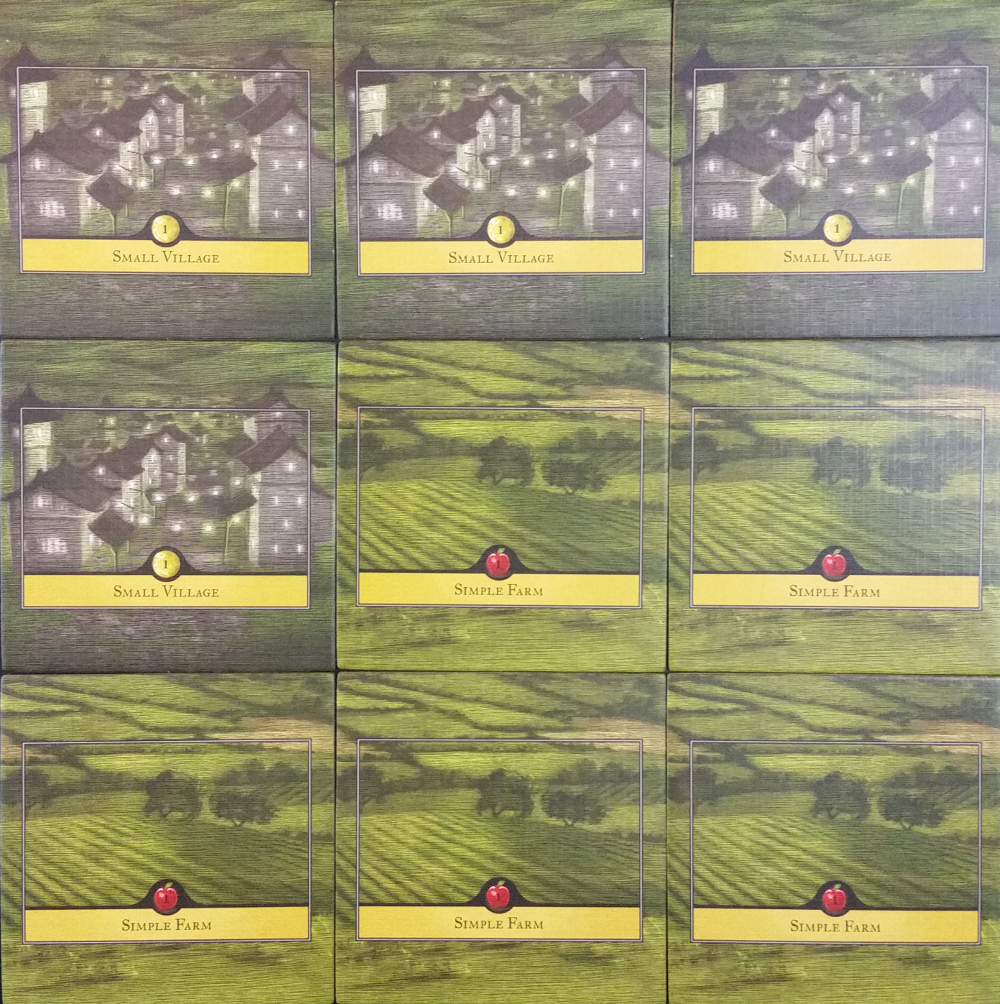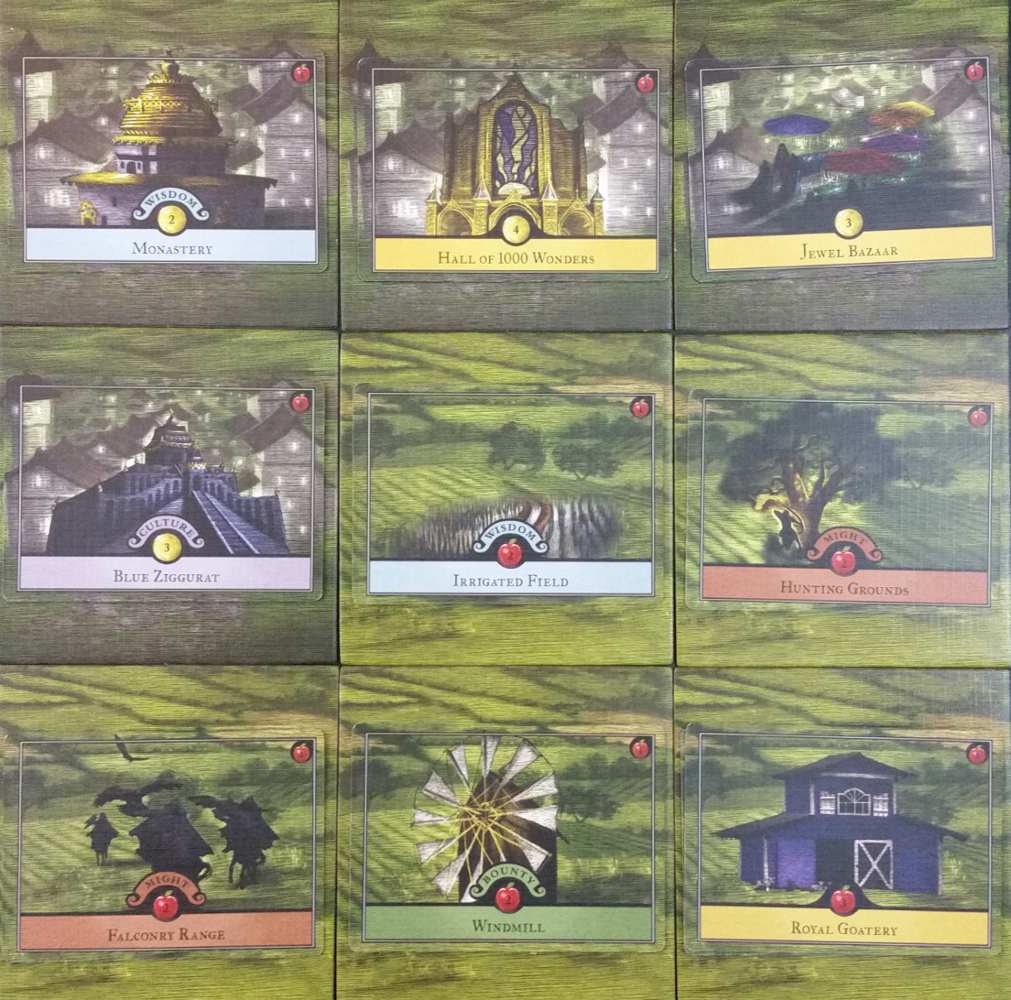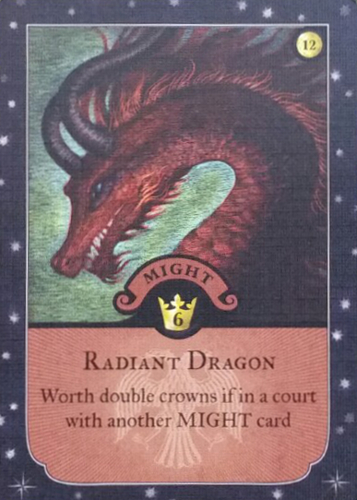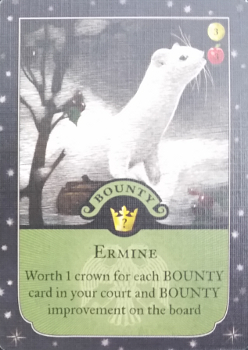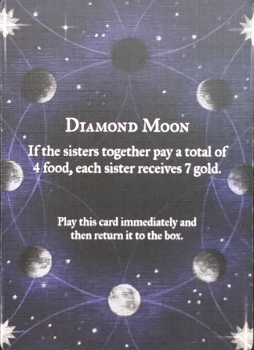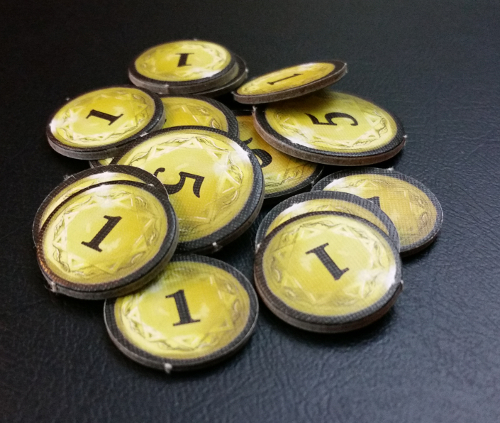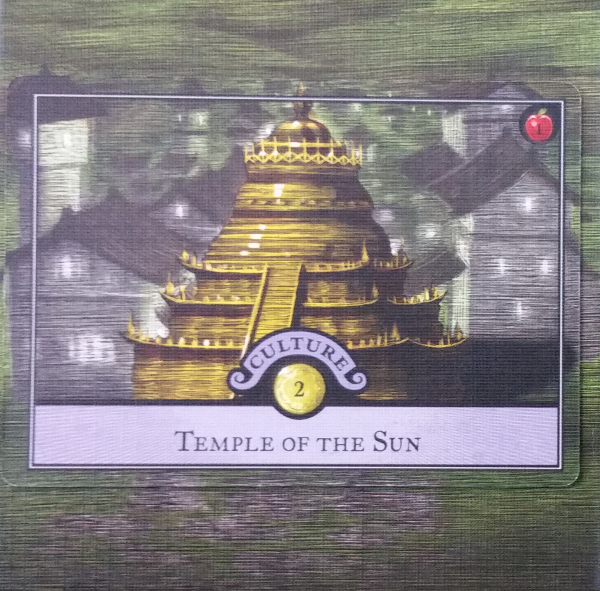Dearest Daughters,
I fear that my time with you is drawing to an end. Soon, our great nation shall fall into your hands and I can only hope that I have prepared you well for the trials ahead. I have not chosen which of you will succeed me and I do not intend to – a mother never reveals her favorites. This is a matter that must be settled among yourselves. Please have faith that each of you would be a capable leader, and I am confident that whomever attains the throne shall serve with wisdom, kindness, and cunning.
All my love,
Mumsy
The Premise
In the land of Minervia, the Queen Regent is dying, and one of the queen’s four daughters will inherit the throne. Desiring to avoid open hostility and plunging the land into a war of succession, each player acts as one of the daughters and instead must persuade enough of the royal court in their favor to secure the throne.
The Rules
The race for the crown is on in Monarch, a short tableau-building game for 3-4 players. Few preparations are needed, though, and setup is quick, for the game consists almost entirely of a dozen Land tiles, a Market card deck, and food and gold tokens.
To begin, nine of the twelve Land tiles are randomly selected to form the board. Every Land tile is either a Village, which generates gold, or a Farm, which generates food. Next, the Market deck is laid out, with the top five cards revealed to form the Market Row. Finally, each player receives five gold and five food. In Monarch, the youngest player starts.
Monarch is played out over a series of rounds, broken down into turns. A player’s turn is both fluid and short, comprised of four possible actions: Tax, Harvest, Acquire, or Sweep. These actions may be taken in any order. However, a player may only either Tax or Harvest, and may only do so once per turn. To Tax, the player pays 1 food per Village and collects the gold sum value of those Villages. Harvesting allows the player to collect the food sum value of all the board’s Farms.
Acquiring and Sweeping involve the Market and may be done as many times as a player wishes. The Market deck consists of four card types: Land Improvements, Unwanted Guests, Court, and Moons. For the first three the player may use the Acquire action to purchase a card from the Market Row by paying its gold and / or food costs. Land Improvement cards are placed on the board and upgrade the value on a Village or Farm, while Unwanted Guests are worth negative VP and are given to another player when purchased. Yet the most important are Court cards, which are added to a player’s tableau when bought. These cards award VP, although many also provide minor benefits. Lastly are Moon cards – event cards that either punish or reward players equally when revealed from the deck.
Whenever a card leaves the Market Row, a new one is revealed. A player may also pay to Sweep, discarding the entire Market Row for five new cards. Additionally, once per game each player may claim one of Monarch’s five banners. These banners provide a special ability and award VP at the end of the game.
Once a player is done taking actions, it’s the next player’s turn. Turns continue in this manner until one player amasses seven Court cards in their tableau.
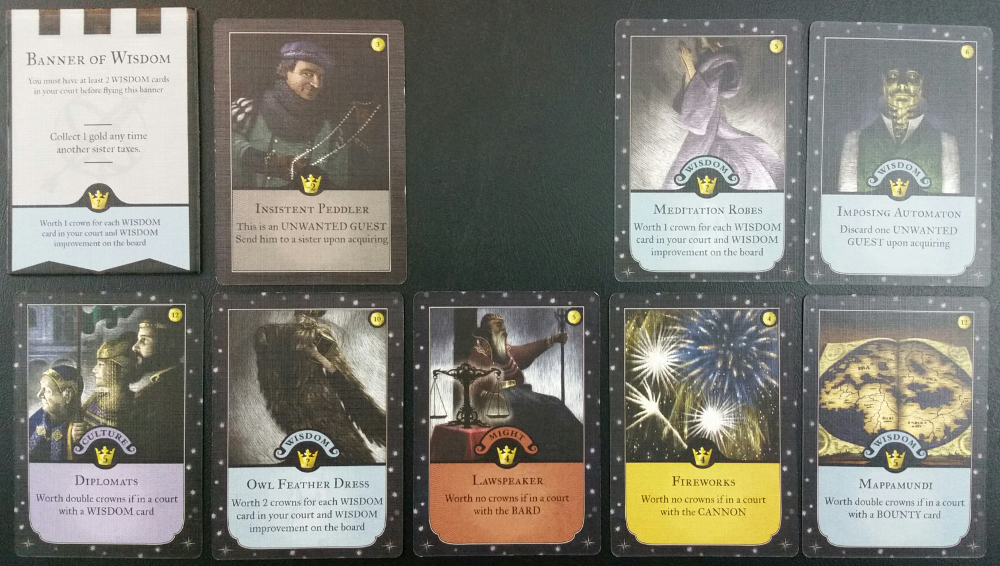
With no Wisdom Land Improvements, this player has a final score of forty-one: 39 in Court cards + 4 from their Wisdom banner -2 from the Insistent Peddler
At that point players finish out the current round and the game ends. Each player tallies the value of their court’s power. The person with the highest VP total is judged the most skilled and capable of the sisters to lead the kingdom and is crowned the new Queen of Minervia.
The remaining sisters will have to be happy and proud for their new ruler…at least publicly.
A Courtly Visage
As powerful rulers and sophisticated aristocrats, royalty have a thing about looking, well, regal. How they hold themselves is key to their ruling persona, whether it’s wise and compassionate or intimidating and authoritative. Monarch does not break with this tradition. One of the first things you’ll notice about the game is how it looks.
This is notable for a couple reasons. First and foremost is that the artwork imparts an ethereal, otherworldly vibe, giving the land of Minervia a sense of mystery. This underpins the idea of a kingdom without a fixed cultural identity yet and that players have an active hand in shaping what its future will look like. This subtlety ties well into Monarch’s tableau style gameplay, and the combined effect lets players feel like their decisions have lasting purpose – should they get to rule.
Secondly, the art doesn’t depict a kingdom in the throes of a fight for succession, with copious knights decked out in weapons and armor, nor does it present a matriarchal kingdom in some Disney-like interpretation of a queen and her four daughters. In fact, Monarch doesn’t even refer to them as princesses; here their roles are merely sisters.
Instead, it presents different kinds of strength, providing a well-rounded look at different succession possibilities besides war. Each banner faction equally represents courtly power, and the game rewards you regardless of which path you follow (partially because 4/5 of the factions are largely functionally identical). Might cards may encompass powerful implements of force such as dragons, cannons, and poisonous creatures, but they’re only one representation how you can rule.
From both a mechanical and flavor standpoint, you’re just as capable of winning in Monarch by amassing nobles and courtly scholars, or being a prosperous provider for your people. Not only is the artwork in Monarch as well done as it is memorable, but it deftly reinforces the game’s premise.
The game’s iconography, however, is less idyllic. For as decent as Monarch’s darker palette looks, it poses a problem with being able to easily read card costs. The cards’ icons for both food and gold are small and use dark numerals, causing them to blend into the background and make them – particularly food symbols – difficult read from across the table.
Conversely, there are also two subsets of cards (Garments and Beasts) that carry watermarks in their text box that can be easily missed because they’re too light. This is problematic as several cards care about them for scoring purposes – which must be inferred since they’re not actually mentioned in the rulebook.
As a result, while Monarch’s combination of purpose and tableau-style building will appease Architects, Immersionists may be rather mixed. This is mainly because aside from minor reference to the sisters on Moon cards, very little of Monarch’s theme is overtly mentioned within the game. They’ll like players building different power bases from the cards, but since most of Monarch’s theme is surface-based, it may not be deep enough for some to hold their courtly interests in the long term.
Truly Blue Moons
A key trait to tableau games is that the focus is primarily on each player developing their own play area. This offers a strategic experience free of interference from other players but at the cost of not being terribly interactive. Monarch attempts to upend this idea through the use of its Moon cards. The execution, though, is slightly uneven.
Moon cards fall into two camps. The first are random event cards, such as causing everyone to lose food or gain gold. Such cards add variety each playthrough but don’t change the game much since they aid or punish equally.
The second group of Moon cards are more interesting, forcing players into a prisoner’s dilemma. These Moons require players to make communal choices, adding participation and mild intrigue into a genre that otherwise doesn’t have you pay much attention to what others are up to. The Hollow Moon, for instance, says that unless players collectively donate three food and gold, everyone loses a Court card. If you’re leading, are you willing to put up a larger portion of the donation? If you’re behind, perhaps you want it to fail. These political Moon cards require tepid negotiation, but they’re resolved quickly and raise engagement without adding complexity.
That said, it’s regrettable Monarch doesn’t have more of these political cards since their appearance makes for one of the most enticing aspects of the game. Of the game’s eight Moon cards, only three force players to collaborate (or not) with one another. These cards work well on both a flavor and mechanical level, but they are sorely underrepresented.
Be that as it may, the larger issue with Moon cards is in their delivery. Moon cards are randomly distributed, and so it’s entirely unpredictable how often you’ll run across their lunar effects. While having the Moons appear at random intervals helps with game variance and represents the unexpected moments that occur when ruling a kingdom, it can also alter the impact or effectiveness of some of the cards. Some sessions can see two or three Moons appear in a single player’s turn, for example, or they can show up at times in the game where their appearance will have less of an effect.
Moon cards unquestionably add value and a slight jolt of whimsy to Monarch, but their presence can often feel too random. Strikers will find the ‘negotiation Moons’ particularly appealing, but the luck-of-the-draw nature of card reveals coupled with the inability to affect other players beyond Unwanted Guests will have them passing on this fight for the throne.
To Rule Is Easy, To Govern…Also Easy
Like the Moons, Monarch offers a second precarious decision-making front in the form of Land Improvement cards. More frequently seen and more impacting on the game overall, these cards pose a recurring conundrum. Over the course of Monarch, you’re frequently tempted with upgrading lands either because they’ll net you points for matching your banner color or because you want to collect extra resources to pay for more valuable Court cards.
The catch is that these upgrades benefit everyone equally, making it easier for your opponents to do the same. Moreover, since aiding your competition is hardly ideal (especially since you’re paying to do it), there’s also the option of players not participating in upgrades at all.
However, Improvements move the game along; complete refusal not only slows the game down but it’s likely to work against you over the course of the game. Wisely, Monarch leaves it up to the players to find the balance between upgrading as needed and keeping opponents in check. And it works. This dynamism doesn’t just change from one playthrough to the next – it can shift even within a game. Plus, upgrading lands is fun. When you pair this simple tension with the game’s short play time and straightforward rule set, expect Socializers to easily want in on this regime change.
On the other hand, though, expect Tacticians and Daredevils to abdicate themselves of the conflict beyond a couple play sessions for the same reasons. While Monarch does an admirable job being concise and captivating lightweight game, both the game’s goal and paths to achieve it are far more linear than these two archetypes prefer.
The Takeaway
It doesn’t take highborn status to recognize Monarch has all the right qualities of a decent tableau-style Gateway Game. With quick turns and an easy to learn ruleset, Monarch gives players light but earnest decisions as everyone amasses the biggest courtly backing they can manage in a scant 45 minutes. The game is then wrapped up in a distinct and thematically fitting visual canvas which reinforces that a game about succession doesn’t have to simply be about warfare. And aside from some minor clarity issues, this pairing succeeds handily. What’s more, although a tableau game, Monarch’s use of communal resource upgrades and Moon cards cleverly raises interplay in a game style where it’s typically lacking, which is laudable even if the game doesn’t utilize Moons to their fullest potential. Even still, between an authentic premise and particular approach, Monarch is one kingdom that may be worth paying a visit to.
Monarch is a product of Mary Flanagan LLC.
Cardboard Republic Snapshot Scoring (Based on scale of 5):
Artwork: 4
Rules Clarity: 4.5
Replay Value: 3.5
Physical Quality: 4
Overall Score: 3.5

